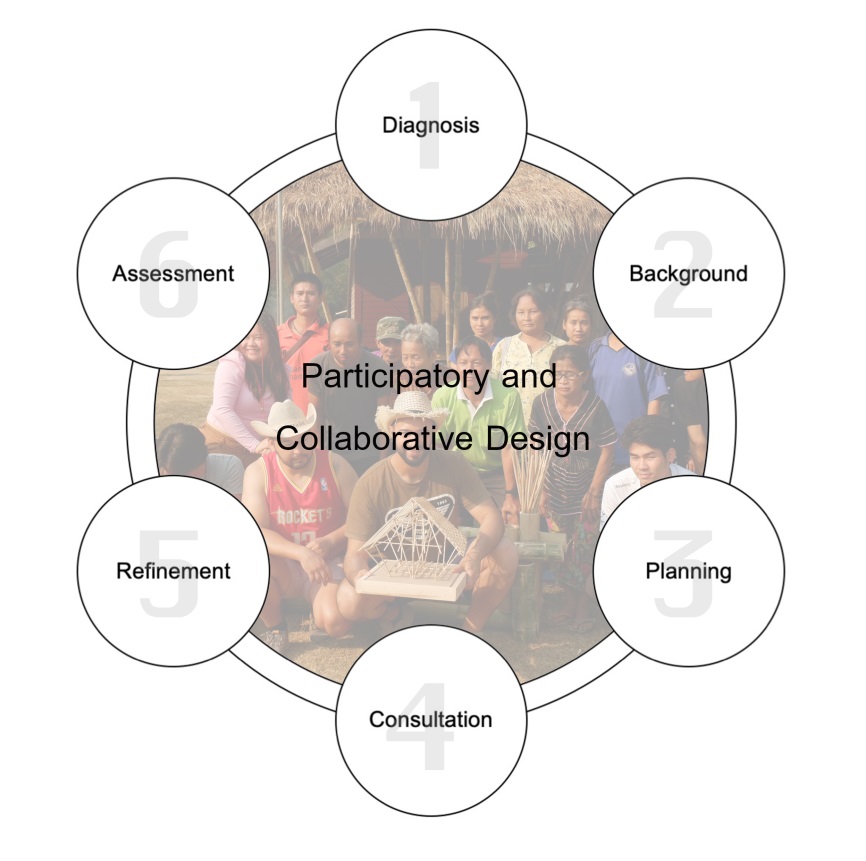Collaboration and Participation in Architectural Design: Lesson Learnt from Building a Bamboo Pavilion with Indigenous Karen
Main Article Content
Abstract
The study of the participatory process in architectural design has been discussed for decades, in which the user is directly involved in the design and decision-making in the design process. The collaborative design process is not just a way to influence building form, but it also indicates the dimensions of users and participants. From academic cooperation in the year 2019-2020 between the School of Architecture, Bangkok University and School of Design and the Built Environment, Curtin University, Australia, has an agreement to study and work together for a period of 10 weeks, focusing on collaboration and participation in the construction of an embroidery bamboo pavilion together with the Karen villagers in Banggloy village, Huai Mae Phrieng Subdistrict, Kaeng Krachan District, Phetchaburi Province. This paper focuses on explaining and discussing the process of collaboration and participation in the design and construction of architecture with the Karen people rather than the results of building construction or building form. The methodology of cooperative inquiry draws on experiential knowing which is through a direct face-to-face encounter with the Karen people; place and culture. The practical outcome of the process is a part of the life experience and collaborative practice between students, both universities and the indigenous Karen. Our learning process involves a much number of closer relationships, providing significant knowledge of person through a reciprocal encounter between people and people, and people and the environment. The limitation of the process is time-consuming, financial cost, and the difference of knowledge background of participants. Also, language communication is a significant challenge. It should be bear in mind that the final product was shaped in respect to all opinions, especially of those who will be regularly occupying the space.
Downloads
Article Details

This work is licensed under a Creative Commons Attribution-NonCommercial-NoDerivatives 4.0 International License.
All material is licensed under the terms of the Creative Commons Attribution 4.0 International (CC-BY-NC-ND 4.0) License, unless otherwise stated. As such, authors are free to share, copy, and redistribute the material in any medium or format. The authors must give appropriate credit, provide a link to the license, and indicate if changes were made. The authors may do so in any reasonable manner, but not in any way that suggests the licensor endorses you or your use. The authors may not use the material for commercial purposes. If the authors remix, transform, or build upon the material, they may not distribute the modified material, unless permission is obtained from JARS. Final, accepted versions of the paper may be posted on third party repositories, provided appropriate acknowledgement to the original source is clearly noted.
References
Al - Kodmany, K. (1999). Using visualization techniques for enhancing public participation in planning and design: process, implementation and evaluation. Landscape and Urban Planning, 45(1), 37–45.
Björgvinsson, E., Ehn, P., & Hillgren, P. (2012). Agonistic participatory design: Working with marginalised social movements. CoDesign, 8(2-3), 127–144.
Botes, L., & Rensburg, D. V. (2000). Community participation in development: Nine plagues. Community Development Journal, 35(1), 41–58.
Broderick, D. (2014). Collaborative Design: Participatory Culture Meets Multiliteracies in a High School Literary Arts Community. Journal of Adolescent & Adult Literacy, 58(3), 198–208.
Chambers, R., & Guijt, I. (2011). PRA five years later. In A. Cornwall (Ed.), The Participation reader, New York: Zed Books, 109–121.
Hussain, S. (2010). Empowering marginalised children in developing countries through participatory design processes. CoDesign, 6(2), 99–117.
Jalowski, M., Fritzsche, A., & Möslein, K. (2019). Facilitating collaborative design: A toolkit for integrating persuasive technologies in design activities. Procedia CIRP, 84, 61–67.
Jenkins, H. (2009). Confronting the challenges of participatory culture media education for the 21st century (John D. & Catherine T. MacArthur Foundation Reports on Digital Media and Learning). Cambridge, MA: MIT Press.
King et. al. (1999). Co-Design: A process of design participation. New York: Van Nostrand Reinhold.
Luck, R. (2003). Dialogue in participatory design. Design Studies, 24(6), 523–535.
Luck, R. (2007). Learning to talk to users in participatory design situations. Design Studies, 28(3), 217–242.
Luck, R. (2010). Using objects to coordinate design activity in interaction. Construction Management and Economics, 28(6), 641–655.
Reason, P. (2011). Cooperative inquiry. In A. Cornwall (Ed.), The Participation reader, New York: Zed Books, 99–108.
Sanoff, H. (2000). Community participation methods in design and planning. Chichester: Wiley.
Sanoff, H. (2007). Special issue on participatory design. Design Studies, 28(3), 213–215.
Sarkissian, W., Walsh, K., & Cook, A. (1997). Community participation in practice: A practical guide. Murdoch, WA: Institute for Science and Technology Policy, Murdoch University.
Selener, D. (1997). Farmer Participatory Research in Participatory Action Research and Social Change, Ithaca, NY: Cornell Participatory Action Research Network, Cornell University.
Sukkasame, S. (2018). Community Participation in Low-income Community Design in Thailand. International Journal of Architecture and Urban Studies, 3(1), 31–37.
Sukkasame, S. (2019). Collaborative Community Design Processes in Rural and Urban Settlements in Thailand. Nakhara: Journal of Environmental Design and Planning, 17, 71–80.
Symes, J., & Jasser, S. (2011). Growing from the grassroots: building participatory planning, monitoring and evaluating methods in PARC. In A. Cornwall (Ed.), The Participation reader, New York: Zed Books, 125–139.


